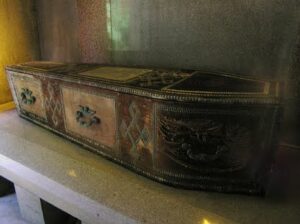Victorian Urban Legends: Coffin Child August 1, 2022
Author: Beach Combing | in : Modern , trackback***I’m putting a series of Victorian Urban Legends posts up to draw the reader’s attention to my just released book: The Nail in the Skull and Other Victorian Urban Legends. This legend (with full references) will appear in a second volume. If anyone can fill in missing pieces or offer other sources… I’ll be grateful and you’ll be credited. drbeachcombing AT gmail DOT com. Note that this week there is also a podcast on Victorian Urban Legends at Boggart and Banshee***
A heavily pregnant woman dies, is interred, is mourned by her family. Then, on the coffin later being opened, it is found not only that the woman was buried alive, but that she had given birth in the coffin. In some cases the child is found huddling next to its mother. It is bad enough, of course, to be Buried Alive (see Nail in the Skull), but for a woman to undergo the ordeal of birth, hopelessly, in a confined space, adds a whole new layer of horror to the story. Here is a case from southern Italy dating to 1877.
One of the most sensational and harrowing cases ever tried in a court of justice was decided in Naples last week before the Court of Appeal. The persons accused were the syndic and the municipal doctor of the small commune of Castel del Giudice, in the province of Molise, and the crime of which they were accused and found guilty was the extraordinary one of what the report calls ‘involuntary homicide’. It appears that a poor woman, being near her confinement, sent for the doctor, who immediately responded to the call, but on arriving he found the patient to all appearances dead, and pronounced her to be so. He was urged to save the child, but refused on the grounds that he believed an operation would be useless. So the woman was buried within twenty-four hours of her decease, in accordance with the law of the land. Some days afterwards the grave was re-opened in order to bury a girl, when, to the horror of the gravediggers, it was found that some displacement had occurred in the body of the woman. The report getting wind, an excited population rose en masse and demanded an immediate official investigation. This was made, and resulted in their finding that the swathings by which the legs had been bound were broken, while the hands were raised to the mouth, as if the poor creature had tried to tear assunder the ribbon which bound them together. Most horrible of all, she had given birth to a male child, which lay dead by her side. The syndic and the doctor were found guilty of ‘involuntary homicide’, and sentenced to three months’ imprisonment each.[1]
There are numerous nineteenth-century cases. Here follows a sample from the later 1800s, when the story was particularly popular. In 1879 a woman gave birth to a baby in a coffin in Russia: mother and child were later discovered dead.[2] In 1887 in Summertown, South Carolina, a woman gave birth in a coffin just as the funeral procession were coming up to the church: ‘The pall-bearers were startled by a crying noise somewhat resembling the mewing of a cat’. [3] This is the only nineteenth-century case known to me where mother and child are said to have survived.[4] In 1890 a woman named Gouda was buried and when the coffin was reopened ‘the corpse of a new-born child was found lying besides its mother’.[5] In the same year Lavrinia [sic] Merli, from near Mantua gave birth in a vault to a seven-month-old child: both were discovered deceased.[6] In 1893 it was the turn of Miss Libbie Jones at Blufton, Indiana with (it is implied) the child of her master who had (again it is implied) murdered his pregnant servant.[7] In 1899 in a particularly well-documented case from France a Madame Bobin was buried while still warm. The body was ‘subsequently exhumed, and a medical examination of the body showed that a child had been born in the coffin’.[8]
Now there is an easy medical explanation for coffin births. ‘The buildup of putrefactive gases inside the cadaver would also result in a highly increased intra-abdominal pressure, which in some instances is strong enough to expel an unborn child from the womb’.[9] But not all nineteenth-century doctors were convinced. In a coffin birth in Hungary in 1890 local doctors argued that the baby had been expelled from a dead mother, but in Budapest opinion was in favour of a cataleptic trance.[10] In 1872 the discovery of a coffin baby in Ireland led to a judicial inquiry and The Lancet, while registering the opinion of local doctors that the child had been born from the dead mother, was clearly sceptical: ‘A close investigation will doubtless show that the child was born before its mother’s funeral, and probably before her death’.[11] Occasional discoveries of ‘expelled’ babies in coffins will have been the rich soil on which this story type grew.
[1] ‘Woman and Child’.
[2] ‘A Terrible Story’.
[3] ‘Born in a Coffin’ (17 Dec 1887).
[4] Bolte, ‘Die Sage’, 365 for a case normally set in the eighteenth century where twins are born in a coffin and the mother is fed and told prophecies there by a ‘boy’ (an angel?). She is discovered when she is heard singing.
[5] ‘Born in a Grave’.
[6] ‘Born in a Coffin’ (8 Jul 1890).
[7] ‘Born in a Coffin’ (2 Sep 1893).
[8] ‘Baby Born in a Coffin’. Officials were later fined ‘Child Born in a Coffin’; see also Bondeson, Buried, 245, who gives though the wrong date.
[9] Bondeson, Buried, 245.
[10] ‘Born in a Grave’.
[11] ‘Childbirth’.



